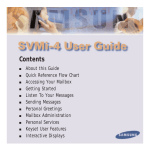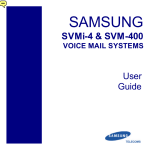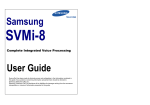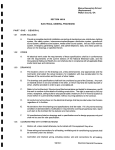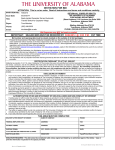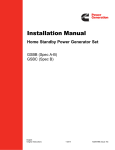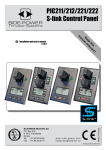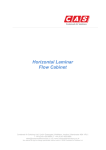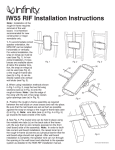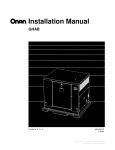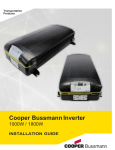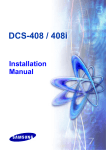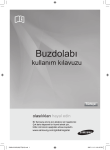Download Division 26 specification sections are founded on the District`s
Transcript
DIVISION 26: ELECTRICAL DESIGN STANDARDS TABLE OF CONTENTS I. PURPOSE II. GENERAL A. STANDARDS AND CODES B. DESIGN DOCUMENTS 1. Document Review C. COMMISSIONING AND INSPECTIONS D. CLOSE-OUT 1. Project Record Documentation 2. Training E. SAFETY F. COORDINATION 1. Permits and Fees 2. Utility Charges 3. Outages G. DEMOLITION AND SALVAGE III. BASIC ELECTRICAL REQUIREMENTS A. SUPPORTING DEVICES 1. Conduits 2. Equipment Support 3. Equipment Pads B. POWER 1. Primary 2. Secondary Main 3. Capacity 4. Quality 5. Transient Surge Suppression 6. Dry-Type Transformers 7. Back-up Power and Standby Generator System a. Diesel generator system b. Engine c. Generator d. Mounting e. Housing f. Fuel storage g. Transfer switch 8. Drawings 9. Testing 10. Service Manual IV. WIRING METHOD A. GROUNDING 1. Ground Rods 2. Ground Connectors BSD Division 26: Electrical Design Standards Revised: 01-11-2010 Page 1 of 22 B. C. D. E. F. G. H. I. V. 3. Equipment Grounding Conductor 4. Telecommunications Bonding Backbone (TBB) 5. Protection 6. Remodels, Retrofits, and Additions 7. Extension PANELBOARDS 1. Manufacturers 2. Service Distribution Switchboards 3. Branch Circuit Panelboards 4. Expansion OVERCURRENT PROTECTIVE DEVICES 1. Fuses 2. Molded Case Circuit Breakers RACEWAYS 1. Underground 2. Dry, Protected Locations 3. Damp Locations 4. Exposed Work in Finished Spaces 5. Conduit Bodies 6. Tele-Power Poles 7. Conduit Installation 8. Fire Stopping BOXES 1. Interior Outlet 2. Floor Boxes 3. Weatherproof Outdoor Outlet 4. Large Junction and Pull 5. Vaults and In-Ground Boxes ELECTRICAL CONNECTION WIRES, CABLES, AND CONNECTORS 1. Power Conductors 2. Insulation 3. MC Cable 4. Connectors 5. Splices, Taps, and Terminations WIRING DEVICES CIRCUIT AND MOTOR DISCONNECTS IDENTIFICATION A. ENGRAVED LABELS B. RECEPTACLES AND SWITCHES C. JUNCTION AND PULL BOXES D. UNDERGROUND UTILITY MARKERS E. PANEL IDENTIFICATION F. BRANCH CIRCUIT SCHEDULES G. ONE LINE DIAGRAM H. SAFETY SWITCHES BSD Division 26: Electrical Design Standards Revised: 01-11-2010 Page 2 of 22 VI. CONTRACTORS AND CONTROL DEVICES A. CONTRACTORS/RELAYS B. TIME SWITCHES C. PHOTOELECTRIC SWITCHES D. EMERGENCY LIGHTING RELAY VII. LIGHTING GUIDELINES A. LIGHT LEVELS B. LIGHT SOURCES 1. Incandescent and Halogen 2. High intensity Discharge (HID) 3. Light emitting Diodes (LED) 4. Fluorescent a. Compact fluorescent (CFL) b. T8 c. T5 1) T5HO (54w) 2) T5 (28w) C. BALLASTS 1. Fluorescent Ballasts 2. High Intensity Discharge (HID) Ballasts D. CONTROLS 1. Switches 2. Occupancy Sensors a. Classrooms b. Restrooms c. Gyms and high ceiling areas d. Small offices and single stall restrooms 3. Daylight Harvesting 4. Lighting Control Panels a. Egress lighting 1) Power outage 2) Occupied building 3) Entry to building (security armed) 4) Unoccupied building (security armed) 5) Security contractor responsibilities 6) Electrical contractor responsibilities E. LUMINAIRES 1. Direct/Indirect 2. Direct 3. Hi-Bay 4. Exit Lights 5. Egress Lighting 6. Emergency Lighting 7. Exterior Lighting BSD Division 26: Electrical Design Standards Revised: 01-11-2010 Page 3 of 22 DIVISION 26: ELECTRICAL DESIGN STANDARDS I. PURPOSE This document is a narrative describing Beaverton School District’s (BSD) Basis of Design for electrical and lighting systems. The information contained herein shall be used by the Architect/Engineer to develop a sustainable and integrated, electrical, lighting and controls system that is economical to construct, maintain, and operate; that enhances learning by providing a safe and suitable work environment for staff and students. This document shall be used as part of the District’s Construction Design Standards. The Architect/Engineer will be responsible for bringing to the attention of the BSD Representative, any variances in design from these guidelines and any opportunities for value engineering. The Architect/Engineer shall provide project-specific, detailed Division 26 specifications, drawings, diagrams, and instructions to assure that the District receives all required electrical systems completely installed, wired, connected, tested, and ready for satisfactory operation by District personnel. These Division 26 Standards were developed with the intent of extending the trouble-free life of equipment, reducing future maintenance problems, and with energy conservation as a priority. Within these goals and project budget constraints, electrical engineering design for District projects should comply with the following hierarchy of priorities: Occupant safety Program compliance/occupant comfort Life cycle cost including maintenance and energy Initial cost Contractor, as referred to herein, represents the project’s General Contractor and its sub-contractors as applicable. II. GENERAL A. STANDARDS AND CODES All work and materials shall conform to all applicable local and state codes and all federal, state, and other applicable laws and regulations. All materials, appliances, electrical equipment, and devices shall be evaluated and listed by an accredited listing agency as accepted by Oregon Revised Statutes. B. DESIGN DOCUMENTS The Architect/Engineer shall provide to BSD, as part of all Design Document Submittals, a narrative with detailed descriptions of system features, functionality, limitations, design assumptions, and parameters. The narrative will be provided as a “deliverable” with the Schematic Design, and will be updated with each subsequent design delivery including Design Development (DD) and Construction Document (CD) phases. The narrative will be detailed enough to provide necessary and beneficial information to future design teams; and will be written in a manner that is informative and useful to building operations personnel. In its final form, this document shall be incorporated into the construction documents and placed on the first sheet of the electrical drawings with a notation that the narrative is for information only and not part of the contract. Drawings shall contain all equipment schedules including panels, lighting, and lighting control panel schedules. The Architect/Engineer shall provide a list and drawing which crossreferences the room numbers originally used on all plans and drawings with the final room BSD Division 26: Electrical Design Standards Revised: 01-11-2010 Page 4 of 22 numbers assigned by the District. The District’s assigned numbers shall be used for all labeling. Design assumptions that define the capabilities of the building shall be documented on the drawings. These include, but are not limited to: electrical load, lighting power density, assumed hours of operation, provisions for future expansion (if any). This will ensure that the information is retrievable years later when only the drawings are available to facility operations. 1. Document Review The Architect/Engineer shall review electrical designs with BSD personnel at the completion of Schematic Design, 100% Design Development, and 80% Construction Documents. C. COMMISSIONING AND INSPECTIONS 1. Commissioning Lighting control systems shall be commissioned by Engineer or independent third party as directed by BSD Representative. 2. Inspections The BSD’s Representative shall be notified at all under-floor, framing, wall cover, and final inspections, so that conduit and wiring routes, junction boxes, panels, and any other pertinent electrical applications can be verified and documented. D. CLOSE-OUT 1. Project Record Documentation Prior to Owner Acceptance, provide three hard copies and one set of PDF files of as-built drawings, operation and maintenance (O&M) manuals, test results for generator system, and commissioning report for lighting control system as applicable to the District representative. As-built drawings shall include the following to reflect actual constructed conditions: One-line diagrams for each system in contract, with sizing information Contractor’s redline drawings showing routing of wiring and other changes shall be provided to BSD Representative at Contract close-out Locations of panels and loads Panel schedules Identify variations from contract drawings to allow accurate location of buried cable Accurate circuit connection designations (numbering at all locations) 2. Training Provide training for appropriate District personnel. Training will review complete O&M manual, including but not limited to, programming and setup of any control systems, required maintenance, and troubleshooting, including contact names and phone numbers for factory support. E. SAFETY 1. Electrical Equipment Secure and limit access to all energized electrical equipment. Electrical equipment and panels shall be behind closed doors or in non-public access areas. 2. Hazardous Materials Including, but not limited, to fluorescent lamps and PCB containing transformers, ballasts and fixtures, must be handled and disposed of in compliance with all applicable BSD Division 26: Electrical Design Standards Revised: 01-11-2010 Page 5 of 22 environmental regulations. Notify the Owner and file all required reports upon discovery of any hazardous materials. All handling or disposal of hazardous materials must be documented and handled in compliance with all current EPA and Oregon DEQ requirements and regulations. F. COORDINATION Coordinate work restrictions with Division 1 of the project specifications and the BSD Representative. Field verify voltage, phase, and ampacity of electrical service and amperage of equipment. Contact and make arrangements with utility providers for service provision. Verify the existence and location of all public utility and BSD-owned underground utilities in the work area(s) before excavating, digging, or drilling. The Contractor shall coordinate with the local utility if meters, transformers, or other equipment belonging to or maintained by the utility shall be disturbed or modified. Charges resulting from failure to obtain proper authorization from the utility shall be paid by the Contractor. BSD shall not be held responsible for any unauthorized utility fees or charges. Damage to utilities or infrastructure shall be repaired at the expense of the Contractor. 1. Permits and Fees The Contractor is responsible for electrical construction permits and permit fees as a cost of the Work. 2. Utility Charges BSD will pay for utility connection fees and charges. 3. Outages A minimum of seven calendar days, in advance, coordinate all electrical service outages with the District and the power company. Confirm outage times with BSD Representative, in advance, a minimum of 48 hours. Plan all work so that the duration of outage is kept to an absolute minimum. Provide temporary wiring as required in order to maintain continuous service to occupied portions of the building during business hours. G. DEMOLITION AND SALVAGE 1. Demolition Contractor shall remove all conduits and wiring listed for demolition to its source and all abandoned conduit and wiring discovered in areas accessed for demolition and construction to its source. 2. Salvage Beaverton School District has first rights of salvage for equipment and materials removed during construction. Coordinate project specific details with the BSD Representative. III. BASIC ELECTRICAL REQUIREMENTS All systems shall be code compliant, complete, and operable. Architect/Engineer is responsible for determining voltage, phase, circuit ampacity, and number of connections. Wiring shall be in conduit unless otherwise noted. When open wiring is permitted raceways will be required in BSD Division 26: Electrical Design Standards Revised: 01-11-2010 Page 6 of 22 insulated walls and other inaccessible areas. All splices, taps, and terminations shall be made at outlet, junction, or pull boxes. A. SUPPORTING DEVICES 1. Conduits Conduits shall be supported within 18” of outlets, boxes, panels, cabinets, and deflections. Maximum distance between supports is not to exceed 5’-0”. Prevent movement and/or sag of junction boxes, pull boxes, or other conduit terminating housings located above suspended ceilings by suspending them from appropriate supports or roof structure. 2. Equipment Support Provide independent supports to structural member for electrical equipment installed in or on ceilings, walls, or in void spaces, over furred or suspended ceilings. 3. Equipment Pads Pads shall be a minimum of 4” thick, reinforced concrete above the adjacent finished floor. Equipment pads shall meet all seismic and code requirements. B. POWER 1. Primary Transformers and power cable for primary feeders over 600 volts shall be furnished, installed, connected, and owned by the serving utility company. 2. Secondary Main At new installations, provide a cost/benefit analysis comparing a single service at 480 volt 3-phase versus two services, one at 480 volt 3-phase and the other at 208 volt 3phase. The desire is to have all transformers located on the utility side of the meters. Single-phase main power is only allowed with BSD Representative approval. 3. Capacity Switchgear and main distribution shall be designed and sized for 150% of the code calculated loads to allow for future expansion in both ampacity and physical capacity. The Architect/Engineer will be responsible for bringing to the attention of BSD Representative, any opportunities for value engineering. 4. Quality Design wiring and specify equipment so that electronic devices that distort the sine wave power, such as computer power supplies, variable speed drives, or solid state fluorescent ballasts, do not adversely affect each other or the building’s power circuits, particularly the neutral wiring. 5. Transient Surge Suppression Transient Surge Suppression is not required on BSD projects, but BSD Representative will consider use based on written request from Architect/Engineer. 6. Dry-Type Transformers Manufacturers: Cutler-Hammer, Siemens, Square D, General Electric Rating: 480 volt, 3-phase primary; 208/120 volt, 3-phase secondary, KVA rating as required. BSD Division 26: Electrical Design Standards Revised: 01-11-2010 Page 7 of 22 Use NEMA Standard TP-1 compliant transformers. Transformer shall be rated for average 115oC temperature rise above 40oC ambient with 100% of rated nameplate load connected to the secondary. Provide mechanical type lugs for conductor terminations. Mount on a vibration mounting pad suitable for isolating the transformer housing from building structure. Transformers may be floor-mounted, wall-mounted, or suspended as required. Provide 4” thick, concrete housekeeping pad above adjacent finished floor for floor mounted transformers. 7. Back-up Power and Standby Generators a. Diesel generator system The following items shall be served by the emergency generator at schools: Exit lights Bathroom lighting Security system Egress/Security lighting Fire Alarm system Provide cost/benefit analysis to determine if the following items shall be served by the emergency generator system: MDF/Office IDF Main office complex lights and power HVAC DDC Controls Boiler and associated pumps Telephone system Intercom system Product refrigeration/freezer Size the generator so the standby KW rating of the generator matches or exceeds the calculated load. Acceptable Manufacturers: Caterpillar, Kohler, Cummins. UL2200 listed. b. Engine Liquid-cooled diesel engine 90 amp hour battery with rack, cables and 2 amp charger Coolant heater Critical exhaust silencer Fuel filter and water separator Air cleaner and oil filter with internal bypass Low coolant, low oil pressure, high water temperature, overcrank and overspeed shut downs 1.5 HP per KW rating Thermostatically controlled block heater Skid mounted radiator with blower fan and fan shroud Electronic governor Oil drain extension Operators Manual c. Generator Rotating exciter mounted to generator shaft through brushless rotating diode system Class F insulation windings per NEMA MG-1 Static type voltage regulator maximum 15 % voltage drop for zero to full load step Electronic governor with 0.5% frequency regulation BSD Division 26: Electrical Design Standards Revised: 01-11-2010 Page 8 of 22 Analog/digital control panel with AC Volt/Amp/Frequency meters with phase selector switch/emergency stop switch with audible alarm/programmable engine control and monitoring output Main line circuit breaker sized to specification Two-year, on-site parts and labor warranty Remote alarm annunciation (digital) from generator and transfer switch to enunciator in school building located, as directed by BSD Representative, with the following alarms at a minimum: High or low voltage, AC and battery Overcrank overspeed High or low frequency Unit not in “automatic” Low or pre-low oil pressure On utility power Low water temperature and level On generator power High and pre-high engine temperature High, low, critical low fuel alarms d. Mounting Skid mounted with internal vibration isolators mounted on a concrete pad and seismic rated spring isolators. Seismic Zone 3 rated. e. Housing Weather housing with rodent guards and sound attenuated enclosure providing a noise level at 3’-0” from the machine under full load of 80dB or less. f. Fuel Storage Twelve hours of diesel fuel in above ground dual wall storage tank g. Transfer Switch 3-pole contactor type mechanically latched Time delay neutral Automated transfer to generator power when utility power is interrupted Automatic transfer back to utility power when restored Adjustable automatic exerciser Use 4-pole type switch with grounded generator when generator backs loads normally served on more than one electrical service 8. Drawings Provide electrical drawings showing all connected loads and circuit schedules 9. Testing Factory testing, field load bank test, and full building load test. Provide a copy of test report to BSD. 10. Service Manual Provide copy of Manufacturer’s Service Manual (or manuals) for all equipment included with the generator system. IV. WIRING METHODS All installations shall meet NECA standards for workmanship. All systems shall be complete and operable. Architect/Engineer is responsible for determining voltage, phase, circuit ampacity, and number of connections. Wiring shall be in cable tray or conduit unless otherwise noted. BSD Division 26: Electrical Design Standards Revised: 01-11-2010 Page 9 of 22 When open wiring is permitted, raceways will be required in insulated walls and other inaccessible areas. All pull boxes, junction boxes, and other enclosures shall be accessible without conflict from other equipment or trades. Pull boxes and junction boxes shall be installed where indicated on the drawings or where required to facilitate wire installation. All splices, taps, and terminations shall be made in outlet, junction, or pull boxes. Use keyed switches in corridors and commons areas to control lighting locally. There shall be no more than six convenience outlets per circuit. Provide a minimum of two convenience outlet circuits in each classroom alternating between outlets. Classroom outlet circuits shall not be used in other rooms or corridors. Provide single circuit outlets for copiers, data/telephone IDFs and MDFs, fire alarm panel, security panel, and where directed or required for a specific use. A. GROUNDING 1. Ground Rods Copper clad steel, ¾” diameter, 10’-0” long, tapered point, chamfered top 2. Ground Connectors Hydraulic compression tool applied connectors where possible, or exothermic welding process connectors. Burndy, Thomas & Betts, Cadweld. 3. Equipment Grounding Conductor Install continuous equipment grounding conductor, code size minimum, in all raceway systems. 4. Telecommunications Bonding Backbone (TBB) Provide a Telecommunications Bonding Backbone. The Telecommunications Main Grounding Bus bar (TMGB) serves as a dedicated extension of the building ground electrode system at the main service equipment room. TMGB shall be bonded with 6 AWG or larger stranded copper cable to the Telecommunications Grounding Bus bar (TGB) at each Telecommunications Frame Room. At each frame room, provide Telecommunication Grounding Bus bar (TGB): ¼” thick by 4” high by 10” long copper ground bar with insulators, Harger, Erico/Cadweld, or approved equal. All racks, ladder trays, and conduit shall be grounded with 6 AWG copper conductor to TGB. BSD Division 26: Electrical Design Standards Revised: 01-11-2010 Page 10 of 22 5. Protection Where exposed, protect ground electrode conductor in rigid PVC conduit. Do not use metal conduit for grounding electrode conductor protection. 6. Remodels, Retrofits, and Additions Evaluate existing grounding and upgrade existing grounding electrode system at main service and dry-type transformers, if necessary, to meet current code requirements. Include re-bonding of main service ground bus to new ground rods. 7. Extension The Contractor shall extend existing grounding electrode systems and equipment grounding systems. The Contractor shall use only approved grounding clamps and connectors as manufactured by Penn-Union, Burndy, or O-Z Mfg. Company. B. PANELBOARDS 1. Manufacturers Cutler-Hammer, Square D, General Electric, Siemen’s. Match manufacturer and breaker style with existing panelboards where applicable. 2. Service Distribution Switchboards Freestanding dead front NEMA 1 enclosure. Plated copper bus bars. Provide fully-rated integrated equipment rating greater than the available fault current. Compression-type lugs rated for both aluminum and copper conductors. 3. Branch Circuit Panelboards Bolt-on circuit breaker type. Plated copper bus bars. Provide fully-rated integrated equipment rating greater than the available fault current. UL series rating is allowable if all upstream panels, including the main service, are installed under this Contract. BSD Division 26: Electrical Design Standards Revised: 01-11-2010 Page 11 of 22 Compression-type lugs rated for both aluminum and copper conductors. Provide double hinge covers. Key all branch panels alike. Provide 20% or more spare circuit capacity for future expansion. 4. Expansion Where distribution equipment, switchboards, panel boards, or control panels are installed, it is required that EMT or IMC, or GRC conduit raceways be installed for a minimum of 5’-0” out of each piece of equipment. Provide two additional ¾” and two additional 1” spare conduits from each panel board to accessible space above and as applicable below panel board for future expansion. C. OVERCURRENT PROTECTIVE DEVICES 1. Fuses Dual element, time delay, current limiting, non-renewable, rejection feature. UL Classes RK1 and L. Provide with indicator window to show when fuse is blown. CooperBussmann, Ferraz-Shawmut, Littelfuse, or approved. 2. Molded Case Circuit Breakers Cutler-Hammer, General Electric, Siemens, Square D. Variable magnetic trip breakers for motor and compressor loads greater than 100A. D. RACEWAYS All conduits shall be installed in a concealed manner where possible and shall be installed parallel to the lines of the building. All conduits shall be a minimum of ¾”. Any exposed conduits shall be installed parallel or at right angles to the building walls or floors. All exposed conduits shall be securely fastened in place on maximum 5’-0” intervals for ¾” through 2½” nominal sizes. Conduit runs shall be continuous from outlet to outlet, outlet to cabinet, and so on. Runs between outlets shall not contain more than the equivalent of three 90° bends. (No more than 270° total in bends.) Conduit bends shall be made with appropriate tools of proper size; radius of bends shall be at least six times the diameter of the conduit. 1. Underground Polyvinyl-Chloride (PVC) Schedule 40 conduit shall be used for all underground installations. Where installed in concrete, provisions shall be made to assure a minimum cover of 2” of concrete. Where installed underground, a minimum of 18” of cover shall be provided. PVC conduit shall transition with a 90°Galvanized Rigid Conduit (GRC) bend where it emerges from the ground or concrete in all locations which it is installed. 2. Dry, Protected Locations GRC, Intermediate Metallic Conduit (IMC), Electrical Metallic Tubing (EMT) If subject to movement or vibration, use flexible metallic conduit. All flexible conduits will not exceed 6’-0” in length and shall be used only in areas where vibrations and/or expansion joints are present. BSD Division 26: Electrical Design Standards Revised: 01-11-2010 Page 12 of 22 3. Damp Locations Conduit and related equipment must be rated and suitable for the application. Use GRC or IMC for cast in place concrete, masonry, damp locations, and areas subject to mechanical damage. If subject to movement or vibration, humidity, water spray, or oil spray, use PVC coated flexible metallic conduit. Sealtite shall be used where flexible conduit connections are required and at connections to all motorized equipment and motors. 4. Exposed Work in Finished Spaces Use metallic raceway in all applications. Under no circumstances should cable bundles be hung from existing electrical conduit systems. 5. Conduit Bodies Conduit bodies are allowed for feeders and branch circuits less than or equal to 100 amps and for signal cabling not related to data communications. 6. Tele-Power Poles Use aluminum construction, two-compartment poles with minimum thickness of 0.05”. Wiremold NP600 series, or approved equal. 7. Conduit Installation Bushings and connectors shall be plastic insulated, lined, 105°C rated. A bushing shall be used where conduit enters a panel box. All heavy wall conduits shall have two locknuts and a bushing at each termination outlet box, junction box, etc., except where terminated in a threaded hub. Fittings on electro metallic tubing (EMT) shall be set screw type with an insulated throat. Expansion fittings shall be provided at all conduits across the building expansion joints. Fittings shall be Type “AX” or “TX” as made by O-Z Electric Company, or approved equal. Provide copper bonding jumper at each expansion fitting. 8. Fire Stopping Coordinate with the Drawings, the location of fire-rated walls, ceilings, floors, and the like. Where these assemblies are penetrated by electrical equipment, seal around the equipment with approved fire-stopping material. In existing facilities, match existing fire stopping material. E. BOXES All pull boxes, junction boxes, and other enclosures shall be accessible without conflict from other equipment or trades. Pull boxes and junction boxes shall be installed where required to facilitate wire installation. Boxes shall be attached by fasteners designed for the purpose and shall provide adequate constraint to prevent movement. All switch, pull, junction boxes, and other enclosures shall be hot dipped galvanized, concrete tight, with interlocking ring. Avoid proximity to heat ducts and/or steam lines. All conduits shall clear ducts or lines and their coverings by a minimum of 6”. BSD Division 26: Electrical Design Standards Revised: 01-11-2010 Page 13 of 22 1. Interior Outlet One-piece boxes and one-piece device covers are required. Minimum box sizes: Galvanized steel, 4” square, 1½” deep Signal system outlets minimum box size: 4” square, 2 1/8” deep 2. Floor Boxes No plastic. All floor boxes shall be code approved metal construction, with rubber gasketed metal covers. Minimum floor box requirements: 3 7/16” deep with 1” factory knockouts 3. Weatherproof Outdoor Outlet Corrosion resistant, cast metal, threaded conduit entry. Corrosion resistant, cast metal, device covers, gasketed. 4. Large Junction and Pull Painted steel, welded seams, screw-on covers. 5. Vaults and In-Ground Boxes Vaults and in-ground boxes shall be installed flush with the ground and shall have the load bearing capacity to support vehicular traffic in all locations. F. ELECTRICAL CONNECTION Verify electrical characteristics of equipment and coordinate voltage requirements with Drawings and equipment cut sheets. Verify phasing and rotation of all motors, compressors, and rotating equipment All splices, taps, and terminations shall be made in outlet, junction, or pull boxes. Provide appropriate cable and cord cap for equipment final connection, as applicable. Verify special purpose outlet NEMA configuration and ampere rating with equipment cut sheet for devices and equipment. G. WIRES, CABLES, AND CONNECTORS 1. Power Conductors All feeder and branch circuit wire shall be 600V insulated-type copper. No wire less than No. 12 gauge shall be used except for control circuits or power limited circuits. Wire sizes No. 12 AWG and larger shall be stranded. All wire sizes shown are American Wire Gauge sizes. Where power conductors are run in cable tray, furnish and install conductors or multiconductor cable rated for use in cable trays per NEC articles 340 and/or 725. There shall be no shared neutrals in multi-wire branch circuit runs. 2. Insulation THHN, THWN or XHHW. Minimum 90oC insulated rating for feeders and branch circuits. 3. MC Cable Use only for branch circuits within a room space with accessible ceiling when branch circuit originates from conduit and wire system in that room. No other locations are acceptable. High strength galvanized steel or aluminum flexible armor, THHN 90C not larger than #10 AWG conductors. There shall be no shared neutrals in multi-wire branch circuit runs. BSD Division 26: Electrical Design Standards Revised: 01-11-2010 Page 14 of 22 4. Connectors Quick push-in wire connectors are prohibited. No.18 to 8AWG, spring connector wire nuts. 5. Splices, Taps, and Terminations All splices, taps, and terminations shall be made in outlet, junction, or pull boxes. Wire to No. 8 gauge shall be spliced using spring connector wire nuts. No. 6 AWG and larger, use indent compression or split bolt connectors for all conductors. Splices No. 6 and larger shall be insulated to voltage rating of feeder or circuit. Splices shall not be permitted in automation input and output wiring without specific written authorization from the Engineer. If such a splice is approved, the location of the splice shall be clearly documented on the as-built drawings. Splices in automation wiring, if necessary, shall be made using Thomas & Betts STA-KON, or approved equal, connectors installed per the manufacturer’s directions to maintain NEMA-specified voltage drops and wire retention forces. H. WIRING DEVICES Manufacturers: Hubbell, Pass & Seymour and Leviton Color: Gray for all devices Wall Switches: Specification Grade Toggle type, 20A, 120/277V Key Switches: Specification Grade Pass & Seymour only for key standardization Receptacles: Specification grade Duplex 20A, 125V, 2-pole, 3-wire grounding GFCI Receptacle: Specification grade Feed-through type, 20-amp, 125VAC Finish Plates: Type 302 stainless steel, satin finish, beveled edge. All locations. I. CIRCUIT AND MOTOR DISCONNECTS Provide disconnect switch in sight of each motor, clearly labeled with circuit and panel identified. Motor disconnects for overhead doors shall be within 24” of motor. Manual Motor Starters: Square D, Class 2510 or equal Safety Switches: Heavy Duty, Class R fuse type V. IDENTIFICATION A. ENGRAVED LABELS Engraved labels shall be plastic laminate, black with white core. Install engraved label on each major unit of electrical equipment, including disconnects, services, distribution panels and branch panel boards, relays, contactors, time switches, override switches, main and satellite control panels of each signal system. Install engraved label on the inside of flush panels, visible when the door is opened. B. RECEPTACLES AND SWITCHES On the back of finish plate, use a label, or legibly write with indelible ink, the circuit to which each device is connected. C. JUNCTION AND PULL BOXES On the cover, use a label, or legibly write with indelible ink, the circuits contained in each box. BSD Division 26: Electrical Design Standards Revised: 01-11-2010 Page 15 of 22 D. UNDERGROUND UTILITY MARKERS Use inert polyethylene plastic ribbon, 6” wide by 4 mils thick. Install continuous tape, 6” to 8” below finish grade, for each exterior underground raceway. Provide trace wire in all underground conduits. E. PANEL IDENTIFICATION Label shall identify panel, voltage, and electrical source. Each electrical panel ID should start with number where "2" will indicate 208/120V system and "4" will indicate 480/277V system. Example: 2A4 / XFMR-T1 / MDP4 208/120V Identifies 208/120 V Panel 2A4, fed from XFMR-T1, fed from MDP4. F. BRANCH CIRCUIT SCHEDULES Schedules shall be typewritten with separate columns for odd and even numbers, using final building room numbers and identifications. The Architect/Engineer shall provide a list and drawing which cross-references the room numbers originally used on all plans and drawings with the final room numbers assigned by the District G. ONE LINE DIAGRAM Laminated one-line diagram showing disconnects shall be posted in main electrical room. H. SAFETY SWITCHES All disconnects shall have plastic laminate labeling identifying distribution or panel board, circuit number, and equipment served. VI. CONTACTORS AND CONTROL DEVICES See Division 23: HVAC for Motor Starters, VFDs, and Motor Controls A. CONTACTORS/RELAYS Lighting and Power, electrically operated-mechanically held. Asco, Cutler-Hammer, Siemens, Square D. B. TIME SWITCHES Seven day, 24 hours, Digital Astronomical Time clock with automatic adjustment for daylight savings and leap year. LCD display. 9V battery backup to retain schedules. Intermatic or equal. C. PHOTOELECTRIC SWITCHES 120VAC, 1800VA, adjustable light level slide. Intermatic, Paragon, Tork. D. EMERGENCY LIGHTING RELAY UL924 listed. On-board test switch for local inspection. Indicator lights for presence of normal utility power, un-switched emergency power, and for when test switch is activated, causing emergency lamps to activate. VII. LIGHTING GUIDELINES Lighting designs for the Beaverton School District shall minimize energy use while creating an environment to enhance learning. Classroom lighting design shall provide a visually exciting environment with minimal glare. This is best accomplished through providing illumination on both horizontal and vertical surfaces, integrating both energy efficient electric lighting and diffuse day BSD Division 26: Electrical Design Standards Revised: 01-11-2010 Page 16 of 22 lighting into the design, and preventing penetration of direct sunlight while using controls to harvest energy savings from the daylight contribution. A. LIGHT LEVELS Light levels in all spaces shall be designed to be in compliance with Illumination Engineering Society of North America (IESNA) guidelines and to meet NFPA 101 standards. The BSD’s goal is to achieve lighting power densities 30% below Oregon Energy Code by combining efficient luminaires with good lighting design. The following are Beaverton School District’s standards for average, maintained (horizontal) foot-candles for each space type: Space Type Classrooms Cafeteria and Gyms Restrooms and Locker Rooms Corridors and Stairways Offices Storage Kitchen (Food Prep area) Light Level (Foot-candles) 35-50 20-30 20-30 10-20 30 15 75 Special Spaces High School Competition Gym 50-80 B. LIGHT SOURCES Light sources should be evaluated on the basis of energy efficiency, lamp life, light quality, control capability, initial cost, and ease of maintenance. Lighting designs shall make use of the most energy efficient sources that give quality lighting, provide appropriate control capability, and be cost effective when evaluated on a life-cycle basis. 1. Incandescent and Halogen Use incandescent and halogen lamps only for special applications where characteristics of incandescent lamps make them the best design choice. 2. High Intensity Discharge (HID) Pulse Start Metal halide is the preferred light source for parking lot lighting and in athletic stadiums. Do not use metal halide for interior lighting at BSD. Current Oregon Law (ORS 332.207) prohibits the use of most metal halide lighting for interior lighting and under covered areas at schools. 3. Light Emitting Diodes (LED) Light Emitting Diodes (LED) shall be used for exit signs. LEDs are an emerging technology that at the current state of the technology should only be used for lights with long operating hours or limited maintenance access. The lighting designer should bring to the attention of BSD, additional applications for use of LEDs as the technology improves and they become more economical. 4. Fluorescent The majority of lighting in BSD buildings is fluorescent. Fluorescent lamps shall have a CRI (color rendering index) of greater than 80 and correlated color temperature of 3500K. The industry standard lamp designation for this is 835. BSD Division 26: Electrical Design Standards Revised: 01-11-2010 Page 17 of 22 There are three main styles of fluorescents acceptable for use in new construction at BSD. These are Compact Fluorescents (CFL), and two types of linear fluorescents: T8s and T5s. a. Compact fluorescents (CFL) CFL luminaires must be designed specifically for compact fluorescent lamps with socket/pin type bases and that use electronic ballasts. Luminaires that use screw-in CFL lamps are not acceptable. b. T8 T8s are 1” diameter linear fluorescent tubes. The standard four foot long T8 is the BSD preferred lamp for most applications. U-tube T8 lamps may be used for specific applications. The lamp/ballast combination in T8 luminaires shall meet the CEE (Consortium for Energy Efficiency) High Performance T8 specification. c. T5 Use of T5 luminaires requires BSD approval at beginning of DD. T5s are 5/8" diameter fluorescent tubes. The standard T5 tube is approximately 45.25” long and cannot be interchanged with a four-foot T8 tube. There are two types of T5 luminaires: standard T5 and high output T5 (T5HO). The standard T5 luminaire uses T5 28 Watt lamps that have similar light output to 32 Watt T8 lamps. The T5 HO luminaire uses T5HO 54 Watt lamps and T5HO ballasts. These luminaires are extremely bright and have a high glare potential. 1) T5HO (54W) Use of high output T5 luminaires shall be restricted as follows: Direct Lighting: T5HO shall not be used for direct or down lighting in luminaires with a mounting height of less than 20’-0”. Indirect Lighting: At mounting heights of less than 20’-0”, T5HO shall only be used as an uplight. 2) T5 (28W) Standard T5 luminaires for direct or indirect lighting are acceptable for use in new construction with BSD approval at beginning of DD. C. BALLASTS All ballasts shall be High Power Factor, less than 20% total harmonic distortion (THD), and have Class P thermal protection. 1. Fluorescent Ballasts Fluorescent ballasts shall meet the above criteria plus the following: Electronic ballasts, sound level rating A, ballast frequency greater than 40 kHz. T8 ballasts that meet the criteria above meet the current CEE High Performance T8 specification. High Power Factor Electronic Ballasts for T8 lamps are available as low, standard, or high ballast factor. (Ballast factor is measure of light output of the actual ballast when compared to a reference ballast. Power factor is a measure of ballast efficiency and effect on power quality.) Ballast factor shall be selected to minimize energy use in the space while still providing the appropriate light levels. BSD Division 26: Electrical Design Standards Revised: 01-11-2010 Page 18 of 22 Continuous Dimming Fluorescent ballasts shall be capable of dimming between 5% and 100% of total output with proportional reductions in energy use, without affecting power, quality, or increasing noise levels. Step Dimming Fluorescent ballasts are acceptable to create bi-level lighting control in a space. 2. High Intensity Discharge (HID) Ballasts Pulse start. D. CONTROLS 1. Switches Switches shall be located in the space that they control. Spaces with multiple entries shall be provided with three-way or four-way switches as appropriate. Switches shall be located by each of the doors. Switches in corridors and public spaces shall be keyed switches, Pass & Seymour only, to provide District-wide key standardization. Bi-level switching (to provide high and low light levels in each luminaire, typically 50% and 100%) shall be provided in all classroom luminaires. Use occupancy sensors to automatically turn OFF all classroom lighting, and a Sentry switch or equivalent to require manual switching to turn on lights to 100% output. The row of lights closest to the white board/projection screen shall be capable of being switched off independently of the classroom lighting. The remaining classroom lighting shall be able to be operated at 50% or 100% light levels during video instruction. 2. Occupancy Sensors Occupancy sensors shall be used to control lighting in classrooms, restrooms, corridors, gyms, multi-purpose rooms, cafeterias, and small offices. Occupancy sensors shall provide complete coverage of area to prevent nuisance OFFs even when the only activity is writing on a desktop or typing at a computer keyboard. Occupancy sensor circuits shall be wired to allow OFF override of the lighting in the area. The occupancy sensor system shall be designed to have no effect on power quality or ballast inrush current. Occupancy sensors and their related relays shall incorporate "zero-crossing circuitry.” BSD has standardized Watt Stopper brand of occupancy sensors, or equal, upon approval. a. Classrooms Two dual technology occupancy sensors shall be used in all classrooms unless approved by the BSD Representative. Sensors shall be set to time-out after five to 10 minutes of no activity. b. Restrooms Multi-stall restrooms shall use ultrasonic technology sensors to detect occupancy inside stalls and around corners. Other technology only with BSD approval. Restroom occupancy sensors should be set to time-out after 12 to 15 minutes. c. Gyms and high ceiling areas Passive Infrared (PIR) sensors are to be used in areas with ceiling heights greater than 14’-0”. Wire guards are required to protect sensors from projectiles. BSD Division 26: Electrical Design Standards Revised: 01-11-2010 Page 19 of 22 d. Small offices and single stall restrooms Wall switch occupancy sensors are acceptable for use in small offices and single stall restrooms if the sensors have a clear view of the space. The occupancy sensor shall control the run time for restroom exhaust fans and be set to time-out after five to seven minutes. 3. Daylight Harvesting Daylight harvesting controls shall be incorporated into the lighting controls design where there is a significant contribution to the lighting from daylight. Sensor set points should be selected to maintain appropriate light levels and incorporate a large enough dead band to prevent cycling on days with partial cloud cover. 4. Lighting Control Panels Lighting control panels shall be used to control egress lighting, lighting in commons areas, lighting in kitchens, and parking lot and exterior building lighting. The lighting control panel shall be capable of network connection and communication through a single IP address. The lighting control panel shall be interconnected with the building security system to shut off all controlled lighting when the security system is armed. The lighting control panel shall be programmed per District requirements. Obtain schedule from BSD Representative. Other than egress lighting and exterior lighting, all other lighting zones controlled by the lighting control panel shall allow the occupant to manually override the schedule through an input to the lighting control panel. Acceptable manufacturers: Greengate ControlKeeper, LC&D, Watt Stopper a. Egress lighting The control parameters for egress lighting are as follows: 1) Power outage All lighting fails to the ON position. 2) Occupied building Egress lights will be turned ON when building is occupied (security disarmed). 3) Entry to building (security is armed) Egress lights will be turned ON to light a pathway to the security panel when the designated main entry door is opened. If security has not been disarmed within 10 minutes, egress lights will shut OFF. 4) Unoccupied building (security is armed) Egress lights will be turned OFF when building is unoccupied. There will be a 10-minute time delay before shutting lights OFF when security is armed. As a warning, the egress lights will blink when the security panel is “coded out.” 5) Security contractor responsibilities Provide the following Form C dry contact output signals from the security panel to a connection block adjacent to the security panel for connection to the lighting control panel: Signal to monitor security armed status Signal to monitor security disarmed status Signal for door opening only when security is armed BSD Division 26: Electrical Design Standards Revised: 01-11-2010 Page 20 of 22 If the building does not have a lighting control panel and lighting control is performed by relays and/or contactors, provide the dry contact signal through “ice cube relays” rated at a minimum of 10a 120v/277v. Security contractor shall be available to coordinate with the electrical contractor to terminate the outputs and test the lighting control system. Electrical contractor shall document and provide a copy to the BSD Representative. 6) Electrical contractor responsibilities Provide the lighting control panels as outlined above. Extend wiring from the lighting control panel inputs to the security panel. Provide for all time delay and timeout functions whether provided through relay logic or Lighting Control Panel Provide for the blink function to warn occupants that building is coded out and lights will be turning OFF. If line voltage from relays and or contactors is utilized instead of lighting control panels, provide clear labeling indicating the voltage of the leads on the Load side of the relays. The labeling should include circuit number and panel identification number Coordinate with the security contractor to terminate the wiring and perform tests to demonstrate operation in the presence of the BSD Representative. E. LUMINAIRES All luminaires must use a standard ballast regularly manufactured by Advance, Osram Sylvania, or General Electric. Luminaires that require proprietary ballasts or lamps will not be accepted. Tandem wiring of luminaires is discouraged and requires Owner approval. Master slave ballast systems will not be accepted. 1. Direct Indirect Pendant mounted, three-lamp, two up, one down. Particular concern should be given to protecting lamps and louvers from collecting debris and projectiles. 2. Direct Use two lamp, advanced lensed 3. Hi-Bay Use specular reflectors impact resistant lens with wire guards in gyms and multi-purpose rooms. 4. Exit Lights LED lighting aluminum or PVC housing, with stencil lettering 5. Egress Lighting Hallways, stairways, and restrooms shall have egress lighting. 6. Emergency Lighting Egress/security lighting, exit lights, and main office complex shall be supported by standby generator. BSD Division 26: Electrical Design Standards Revised: 01-11-2010 Page 21 of 22 7. Exterior Lighting Exterior lighting shall be controlled by astronomical time clock for small remodels. Use lighting control panel for all new construction. Exterior lighting shall be designed to minimize light pollution, light trespass, and glare. Beaverton School District has adopted a “night blackout” or “dark campus” policy. All exterior lights and interior lights other than exit signs are shut off when the building is unoccupied and the security system is armed. This results in a “dark campus” between the hours of 11:30 PM and 5:30 AM and on weekends for most campuses. See Lighting Control Panels section for details. BSD Division 26: Electrical Design Standards Revised: 01-11-2010 Page 22 of 22























